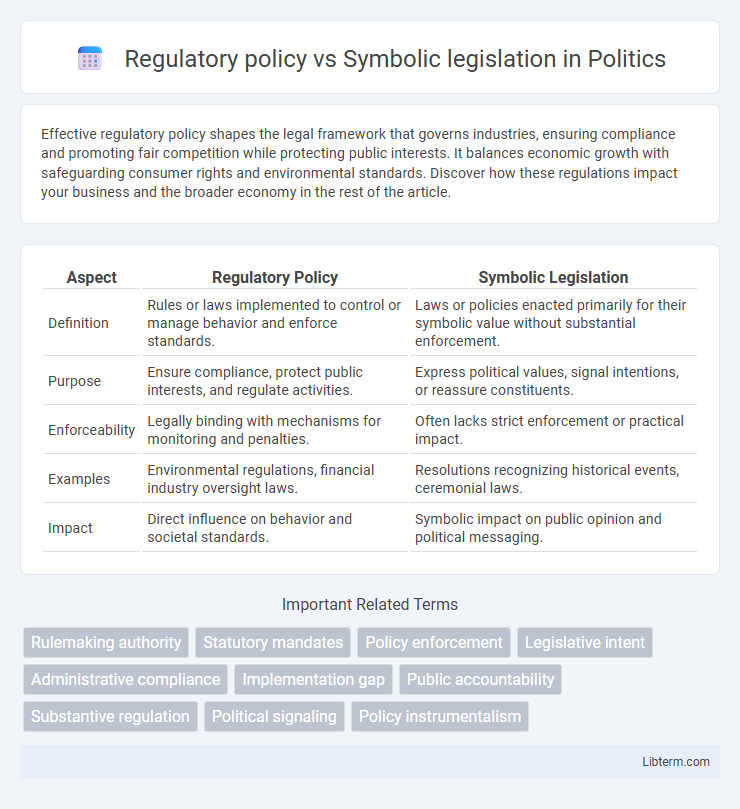Effective regulatory policy shapes the legal framework that governs industries, ensuring compliance and promoting fair competition while protecting public interests. It balances economic growth with safeguarding consumer rights and environmental standards. Discover how these regulations impact your business and the broader economy in the rest of the article.
Table of Comparison
| Aspect | Regulatory Policy | Symbolic Legislation |
|---|---|---|
| Definition | Rules or laws implemented to control or manage behavior and enforce standards. | Laws or policies enacted primarily for their symbolic value without substantial enforcement. |
| Purpose | Ensure compliance, protect public interests, and regulate activities. | Express political values, signal intentions, or reassure constituents. |
| Enforceability | Legally binding with mechanisms for monitoring and penalties. | Often lacks strict enforcement or practical impact. |
| Examples | Environmental regulations, financial industry oversight laws. | Resolutions recognizing historical events, ceremonial laws. |
| Impact | Direct influence on behavior and societal standards. | Symbolic impact on public opinion and political messaging. |
Introduction to Regulatory Policy and Symbolic Legislation
Regulatory policy involves the implementation of rules and standards designed to control behavior within specific sectors, aiming to address economic, social, or environmental issues through enforceable measures. Symbolic legislation, by contrast, consists of laws enacted primarily to convey values or political messages without significant practical enforcement or impact on behavior. Understanding the distinction between these approaches is crucial for analyzing the effectiveness of lawmaking in achieving policy goals and public accountability.
Defining Regulatory Policy
Regulatory policy involves the creation and enforcement of rules by government agencies to control behavior and ensure compliance with laws, directly impacting industries such as finance, healthcare, and environmental protection. It is characterized by binding obligations, penalties for non-compliance, and mechanisms for monitoring and enforcement, making it a practical tool for achieving specific policy goals. Symbolic legislation, in contrast, serves primarily to express values or political support without imposing substantial legal obligations or enforcement measures.
Understanding Symbolic Legislation
Symbolic legislation serves primarily to express societal values or political ideals without imposing significant regulatory effects or legal obligations. It often aims to appease public opinion or demonstrate government stance on issues, rather than enforce detailed policy measures. Understanding symbolic legislation involves recognizing its role in shaping public discourse and signaling commitments rather than driving concrete regulatory outcomes.
Key Differences Between Regulatory Policy and Symbolic Legislation
Regulatory policy enforces specific rules and standards to control behavior and ensure compliance within sectors such as environmental protection or financial markets, while symbolic legislation primarily serves to express political values or public commitments without direct legal enforcement. Regulatory policies require detailed provisions and mechanisms for monitoring, penalties, and compliance, contrasting with symbolic legislation that often lacks binding authority or concrete implementation steps. The key differences lie in their purpose, legal enforceability, and impact on stakeholder behavior, with regulatory policies designed for practical effects and symbolic legislation aimed at signaling intentions or public support.
Objectives and Purposes of Each Approach
Regulatory policy aims to establish detailed rules that ensure compliance, protect public interests, and address specific economic or social issues through enforcement mechanisms. Its primary objective is to achieve tangible outcomes such as market stability, consumer safety, or environmental protection by imposing clear standards and penalties for violations. Symbolic legislation serves to communicate societal values, signal government commitment, and influence public opinion without necessarily enforcing substantive change, often functioning as a tool to unify or reassure stakeholders.
Impact on Governance and Society
Regulatory policy enforces specific rules and standards, enhancing governance by ensuring accountability, transparency, and effective resource allocation, which leads to measurable societal benefits such as improved public safety and environmental protection. Symbolic legislation often serves to express political values or respond to public sentiment without direct enforcement mechanisms, impacting governance by shaping public discourse and societal norms but often lacking tangible outcomes. The distinction between these approaches affects the legal framework's capacity to drive behavioral change and address social challenges in a concrete manner.
Case Studies: Regulatory Policy in Action
Regulatory policy enforces specific rules and standards affecting industries such as environmental protection, evident in the Clean Air Act's success in reducing pollution levels nationwide. Symbolic legislation often serves to express political values without creating enforceable obligations, demonstrated by state declarations supporting climate change action lacking binding measures. Case studies like the U.S. Environmental Protection Agency's regulatory interventions highlight tangible outcomes of regulatory policy contrasting with the limited impact seen in purely symbolic laws.
Case Studies: Symbolic Legislation Examples
Symbolic legislation often serves to convey values or political messages without enacting enforceable regulatory changes, as seen in the 1990s U.S. flag desecration amendment proposals that failed to achieve constitutional ratification but highlighted patriotic sentiment. Another example includes the 2005 U.S. Congressional "Fairness Doctrine" revival attempts, which symbolized concerns about media bias despite lacking binding regulatory power. These cases illustrate how symbolic legislation influences public discourse and political identity without imposing practical legal constraints.
Criticisms and Challenges of Both Approaches
Regulatory policy faces criticisms for bureaucratic complexity and enforcement inefficiencies, often leading to inconsistent application and regulatory capture. Symbolic legislation is challenged by its tendency to prioritize political signaling over substantive impact, resulting in laws that lack practical enforcement or measurable outcomes. Both approaches struggle with balancing public expectations and effectiveness, as regulatory policies can be perceived as overbearing while symbolic laws risk being dismissed as mere rhetoric.
Policy Recommendations and Future Trends
Regulatory policy involves concrete rules and enforcement mechanisms designed to influence behavior and achieve specific outcomes, while symbolic legislation primarily serves to express values without direct regulatory impact. Policy recommendations emphasize enhancing regulatory clarity, improving stakeholder engagement, and leveraging data-driven evaluation to ensure effective implementation. Future trends indicate increasing integration of technology for regulatory compliance monitoring and a growing demand for adaptive policies that balance symbolic gestures with tangible regulatory effects.
Regulatory policy Infographic

 libterm.com
libterm.com